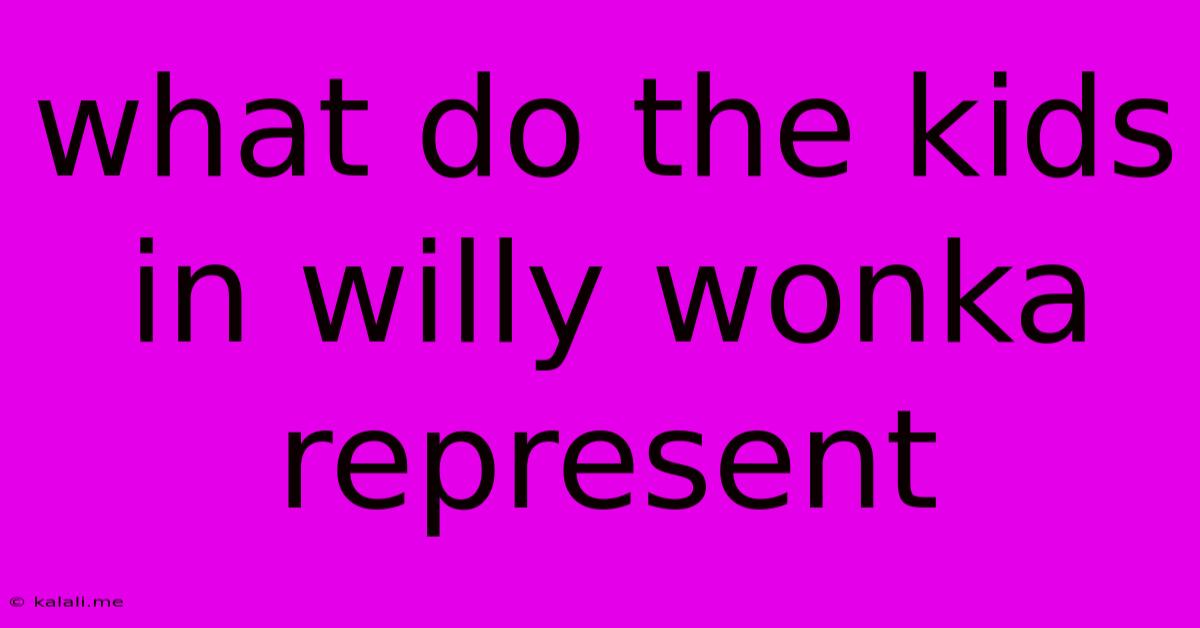What Do The Kids In Willy Wonka Represent
Kalali
May 23, 2025 · 3 min read

Table of Contents
What Do the Kids in Willy Wonka Represent? A Look at the Seven Deadly Sins and More
Willy Wonka & the Chocolate Factory, while a whimsical children's film, offers a surprisingly deep exploration of human nature. The five children chosen to tour Wonka's factory aren't just quirky characters; they represent various flaws and societal anxieties of the time, acting as cautionary tales masked by sugary delights. This article delves into the symbolic meanings behind each child, exploring their representation of specific vices and societal issues.
A Metaphorical Chocolate Factory: The film's enduring appeal stems from its ability to entertain while subtly critiquing societal norms. Wonka’s fantastical factory serves as a microcosm of society, reflecting the potential consequences of unchecked greed, selfishness, and lack of discipline.
The Sinful Children: A Breakdown
The most prevalent interpretation associates the children with the seven deadly sins, although not all sins are explicitly represented. Here’s a breakdown:
-
Augustus Gloop: Gluttony personified. His insatiable appetite and lack of self-control lead to his sticky demise. He represents the dangers of unchecked indulgence and a disregard for consequences. His plump physique further emphasizes his excessive consumption.
-
Veruca Salt: Spoiled brat and greed. Veruca's demanding nature and entitled attitude highlight the negative impacts of unchecked materialism and a sense of entitlement. Her constant demands and disregard for others exemplify the destructive nature of greed.
-
Violet Beauregarde: Pride and arrogance. Violet’s competitive spirit and desire to always be the best, even if it means breaking rules and disregarding warnings, embody hubris and arrogance. Her transformation into a giant blueberry is a physical manifestation of her inflated ego bursting at the seams.
-
Mike Teavee: Obsession and addiction to technology. While not a traditional deadly sin, Mike’s unhealthy obsession with television foreshadows the dangers of excessive screen time and its potential to disconnect individuals from reality. His shrinking demonstrates the negative consequences of a life dominated by the passive consumption of media.
Charlie Bucket: The Virtuous Exception
In stark contrast to the other children, Charlie embodies humility, kindness, and gratitude. His poverty doesn't define him; instead, it underscores his inherent goodness and appreciation for simple pleasures. Charlie's win isn't just about luck; it's a reward for his virtuous character. He represents the ideal child – hardworking, respectful, and appreciative – providing a strong counterpoint to the spoiled and self-centered counterparts.
Beyond the Seven Deadly Sins: Broader Societal Commentary
The film also offers commentary beyond the individual flaws of the children. Their actions reflect anxieties about:
-
Consumerism: The children's obsessions with sweets and toys mirror the burgeoning consumer culture of the 1970s, highlighting the dangers of excessive consumption and materialism.
-
Parenting Styles: The parents’ roles (or lack thereof) underscore the societal debate surrounding parenting styles and their impact on children's behavior. The parents' complacency often exacerbates the children's negative traits.
-
Class Inequality: The stark contrast between Charlie's poverty and the other children's wealth highlights the societal disparities of the era.
Conclusion:
The children in Willy Wonka are more than just whimsical characters; they are symbolic representations of human flaws and societal issues. Their journey through the chocolate factory serves as a cautionary tale, highlighting the importance of moderation, humility, and appreciating the simple things in life. The film's enduring popularity lies in its clever use of allegory, making it a timeless classic that continues to resonate with audiences today.
Latest Posts
Latest Posts
-
Turn Square Face Into Octagon Blender
May 24, 2025
-
Is Birthday Capitalized In Happy Birthday
May 24, 2025
-
Does A Refrigerator Need A Special Outlet
May 24, 2025
-
Car Completely Dead No Lights How To Start It
May 24, 2025
-
How To Remove Stripped Bolt And Nut
May 24, 2025
Related Post
Thank you for visiting our website which covers about What Do The Kids In Willy Wonka Represent . We hope the information provided has been useful to you. Feel free to contact us if you have any questions or need further assistance. See you next time and don't miss to bookmark.